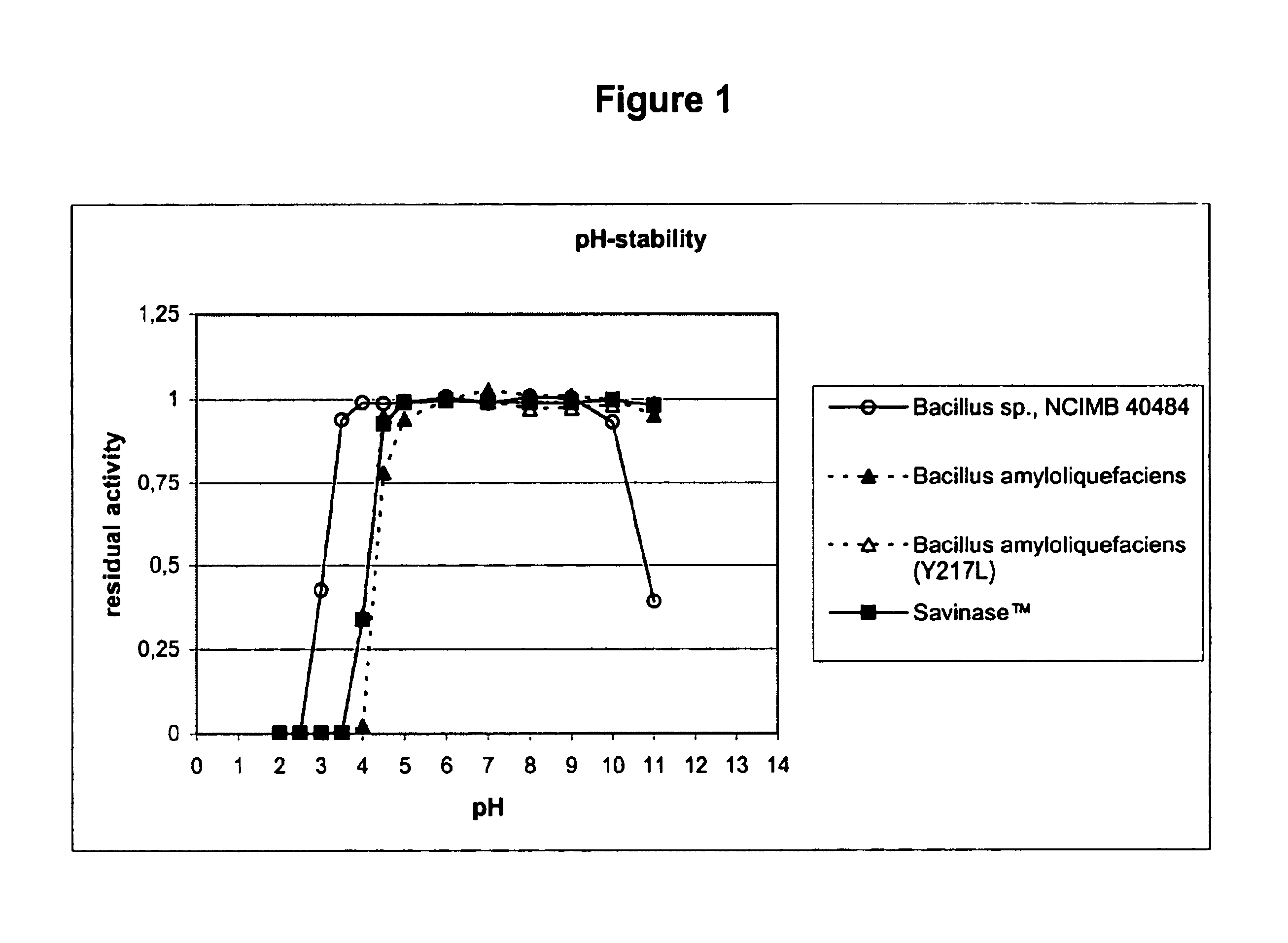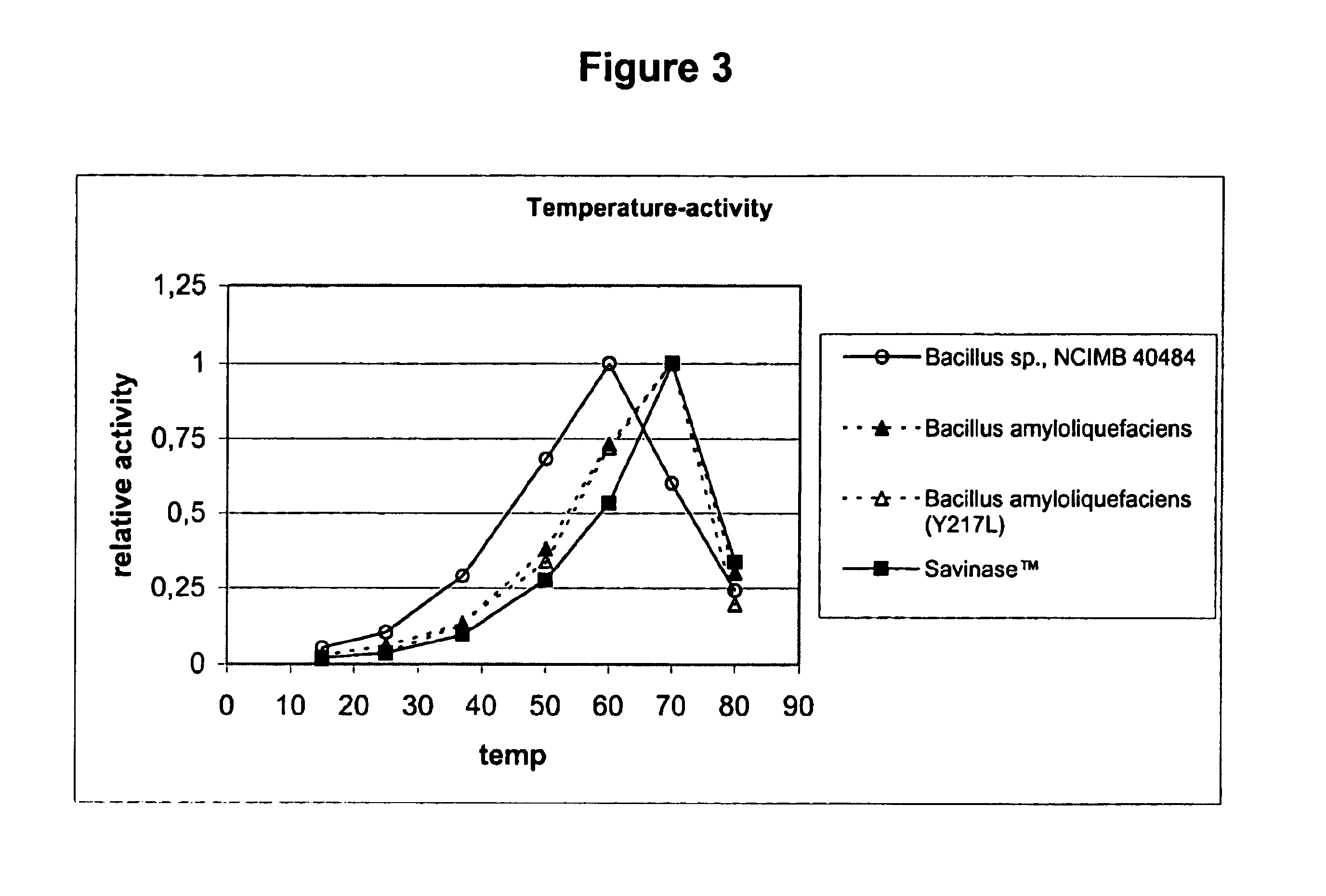Use of acid-stable subtilisin proteases in animal feed
a protease and acid-stable technology, applied in the field of use of serine proteases and acidstable, can solve the problems of not being acid-stable, and achieve the effect of improving the performance of animal feed
- Summary
- Abstract
- Description
- Claims
- Application Information
AI Technical Summary
Benefits of technology
Problems solved by technology
Method used
Image
Examples
example 1
Screening for Acid-stable Proteases
[0136]A large number of proteases were analysed for stability at pH 3, with the objective of identifying proteases that have the necessary stability to pass through the acidic stomach of mono-gastric animals.
[0137]The proteases had been purified by conventional chromatographic methods such as ion-exchange chromatography, hydrophobic interaction chromatography and size exclusion chromatography (see e.g. Protein Purification, Principles, High Resolution Methods, and Applications. Editors: Jan-Christer Janson, Lars Rydén, VCH Publishers, 1989).
[0138]Protease activity was determined as follows: The protease was incubated with 1.67% Hammarsten casein at 25° C., pH 9.5 for 30 minutes, then TCA (tri-chloro acetic acid) was added to a final concentration of 2% (w / w), the mixture was filtrated to remove the sediment, and the filtrate was analysed for free primary amino groups (determined in a colometric assay based on OPA (o-phthal-dialdehyde) by measuring ...
example 2
Characterisation and Comparative Study of the Subtilisin Protease Derived from Bacillus sp. NCIMB 40484
[0141]The protease derived from Bacillus sp. NCIMB 40484 was prepared as described in Example 1 of WO93 / 24623.
[0142]The purpose of this characterisation was to study its pH-stability, pH-activity and temperature-activity profiles, in comparison to Sub.Novo, Sub.Novo(Y217L), and SAVINASE™.
[0143]Sub.Novo is subtilisin from Bacillus amyloliquefaciens, and Sub.Novo(Y217L) is the mutant thereof that is disclosed in WO96 / 05739. Sub.Novo was prepared and purified from a culture of the wild-type strain using conventional methods, whereas the mutant was prepared as described in Examples 1-2, and 15-16 of EP 130756.
[0144]SAVINASE™ is a subtilisin derived from Bacillus clausii (previously Bacillus lentus NCIB 10309), commercially available from Novozymes A / S, Krogshoejvej, DK-2880 Bagsvaerd, Denmark. Its preparation is described in U.S. Pat. No. 3,723,250.
example 2a
Determination of SDS-PAGE Purity of Protease Samples
[0145]The SDS-PAGE purity of the protease samples was determined by the following procedure:
[0146]40 μl protease solution (A280 concentration=0.025) was mixed with 10 μl 50% (w / v) TCA (trichloroacetic acid) in an Ep-pendorf tube on ice. After half an hour on ice the tube was centrifuged (5 minutes, 0° C., 14.000×g) and the supernatant was carefully removed. 20 μl SDS-PAGE sample buffer (200 μl Tris-Glycine SDS Sample Buffer (2×) (125 mM Tris / HCl, pH 6.8, 4% (w / v) SDS, 50 ppm bromophenol blue, 20% (v / v) Glycerol, LC2676 from NOVEX™)+160 μl dist. water+20 μl β-mercaptoethanol+20 μl 3M unbuffered Tris Base (Sigma T-1503) was added to the precipitate and the tube was boiled for 3 minutes. The tube was centrifuged shortly and 10 μl sample was applied to a 4-20% gradient Tris-Glycine precast gel from NOVEX™ (polyacrylamide gradient gel based on the Laemmli chemistry but without SDS in the gel, (Laemmli, U. K., (1970) Nature, vol. 227, pp...
PUM
| Property | Measurement | Unit |
|---|---|---|
| pH | aaaaa | aaaaa |
| temperature | aaaaa | aaaaa |
| pH | aaaaa | aaaaa |
Abstract
Description
Claims
Application Information
 Login to View More
Login to View More - R&D
- Intellectual Property
- Life Sciences
- Materials
- Tech Scout
- Unparalleled Data Quality
- Higher Quality Content
- 60% Fewer Hallucinations
Browse by: Latest US Patents, China's latest patents, Technical Efficacy Thesaurus, Application Domain, Technology Topic, Popular Technical Reports.
© 2025 PatSnap. All rights reserved.Legal|Privacy policy|Modern Slavery Act Transparency Statement|Sitemap|About US| Contact US: help@patsnap.com



